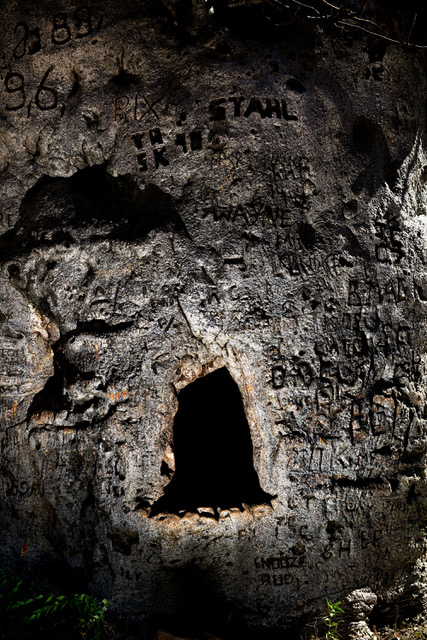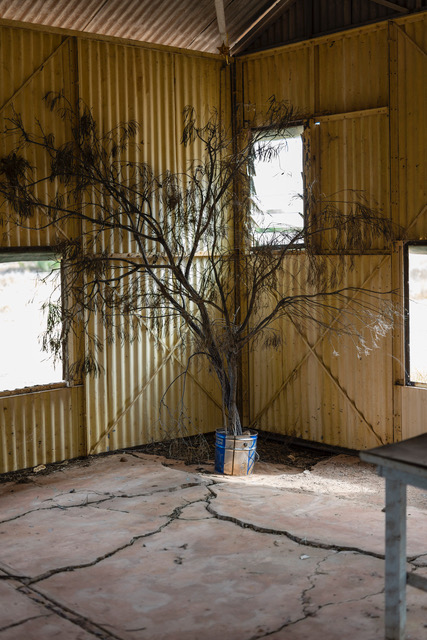Liss Fenwick
Liss Fenwick
 Liss Fenwick, Boab tree covered by a century of tourist graffiti, mythologised as the Hillgrove Lockup, north Western Australia 2016
Liss Fenwick, Boab tree covered by a century of tourist graffiti, mythologised as the Hillgrove Lockup, north Western Australia 2016 Liss Fenwick, Christmas tree in a church, Newcastle Waters, Northern Territory 2016
Liss Fenwick, Christmas tree in a church, Newcastle Waters, Northern Territory 2016
[This tree] forms a marker for the horror of the frontier wars, but also reveals
something of human nature. It pre-empts greater scars on the landscape
to come through the built environment of the modern era. A shadow of guilt
for the will of my predecessors to carve out space on the land. LISS FENWICK
Knowledge and nomenclature, the act of naming, are intimately tied. The naming of plants is a mode of sharing knowledge within a community, whether that be language group or scientific enclave. In the Nyulnyulan languages of north Western Australia boabs are larrgadiy, in other parts of Australia they are popularly called bullawaddey or bottle trees. The nineteenth century botanist Ferdinand von Mueller named the species Adansonia gregorii after the Australian explorer Augustus Charles Gregory.
This individual boab known as Hillgrove Lockup has lived over 500 years. In that time it has born edible fruits, captured water in its hollow bulbous trunk, and its canopy provided shade in the arid landscape. Its monumental size makes it discernible from great distances. As an iconic landmark it has earned the esteem of local Miriwoong peoples, and travellers, securing its place in history with a recognisable personality.
In contrast, the names, initials and dates that scarify its smooth skin are violent. The graffiti began to appear after European settlement and interpreted through a filter of colonial dominance are thoughtless attempts at immortality. This specific tree shares a darker mythology with another boab in the remote north as site of colonial incarceration. It is believed that the interior was used as a cell to detain Aboriginal people during their transportation to the city.
The Works
Boab tree covered by a century of tourist graffiti, mythologised as the Hillgrove Lockup, north Western Australia 2016
Christmas tree in a church, Newcastle Waters, Northern Territory 2016
Colour inks on plantine fibre rag paper
Courtesy of the Artist
About the Artist
b. 1989, Humpty Doo, Northern Territory. Lives between Melbourne and Humpty Doo.
Liss Fenwick’s work combines documentary-style photography with long-term conceptual and aesthetic visions. Her signature visual language was developed on location, in areas of bush surrounding her rural hometown of Humpty Doo in the Northern Territory and across northern Australia. Underpinning Liss’ creative practice is a keen observation of nature and an appreciation for complex human-ecological connectivities.
Liss is currently undertaking her PhD candidature at RMIT, Melbourne. Her work has been shortlisted for several major prizes across Australia, including Banyule Prize for Works on Paper, Hatch Contemporary (2019); Contemporary Landscapes in Photography Award, Perth Centre for Photography (2019); and Josephine Ulrick and Win Schubert Photography Prize (2018). In 2018, Liss was awarded the Macquarie Group Emerging Artist Prize.



